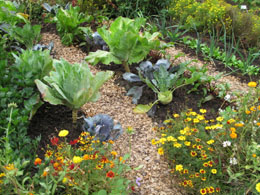Companion planting is a concept that is based on the idea that a combination of different plants would be more beneficial than planting the same variety in a particular area.

Companion planting is a system of growing different types of plants in close proximity, so that they assist and benefit each other. The concept of companion planting dates back to ancient Romans. One classical example of this system is the 'Three Sisters Technique', pioneered by the native Americans. They used to plant corn, pole beans, and squash together. The cornstalks act as poles for the beans to climb, beans fix nitrogen which is used by corn and squash, squash covers the ground, thereby preventing weeds, and retains moisture in the soil. The prickly hair of the squash also helps in deterring pests. The same technique was used in cottage gardens, attached to the English cottages, where both ornamental and edible plants were planted together.
As it is evident from the 'Three Sisters Technique', companion planting is beneficial in many ways, like pest control, pollination, providing nutrients, support, shelter, flavor enhancement, and pattern disruption.
Pest Control
Plants, like marigold, garlic, leek, asparagus, and coriander have pest-repelling property. Hence, they are planted with other crops. It is believed that marigold produces certain chemicals that can repel pests like aphids. It can also attract hoverflies, the predator of aphids. Likewise, garlic is planted with roses, so as to repel pests in rose plants. Another method is to divert pests from their target plants by growing some other plants, which can attract them. It is seen that nasturtium bordering cabbage plants disrupted the pests, especially cabbage root flies. Cabbage root flies prefer nasturtium to cabbage, as the larvae of this insect like to feed on the former than the latter. Clover is also used for this purpose.
Pollination
Plants which produce nectar and pollen, can attract insects. These insects can be beneficial in two ways - pollination of crops and pest control. As adults, these insects undertake the pollination task and in the larval form, they feed on pests.
Nutrient Supply
It is seen that legumes like peas, beans, and lupins can benefit the soil by releasing nitrogen stored in their roots. White clover is also planted in some gardens for the same reason. Another such plant is yarrow, which is grown for increasing the strength and vigor of neighboring plants. Being a storehouse of phosphorous, silica, and calcium, yarrow can be added to compost too. It can also attract beneficial insects, like hoverflies and ladybirds.
Support and Shelter
Growing tall-growing plants with low-growing, shade-loving plants is found to be beneficial for both. Tall plants can provide sufficient shade for the shrubs, and also act as a windbreak. Even creepers can be planted in between, in order to prevent loss of moisture from the soil. Taller plants can support the vines of climbers.
Flavor Enhancement
Planting some herbs with other crops may enhance the flavor of the crops. For example, chamomile can improve the flavor of onions, cabbage, and cucumbers. Planting chamomile in your garden or agricultural area is considered beneficial, as the former is like a tonic for other plants.
Pattern Disruption
Growing a single crop over a wide area increases the chances of higher level of damages due to pest attacks. In companion planting, the pests are disrupted by the companion plants, thereby controlling the damage to some extent.
There are many combinations of plants which are successfully tried as companion plants. You can also employ this system in your garden, and find out some mutually benefiting plants.






 Companion planting is a system of growing different types of plants in close proximity, so that they assist and benefit each other. The concept of companion planting dates back to ancient Romans. One classical example of this system is the 'Three Sisters Technique', pioneered by the native Americans. They used to plant corn, pole beans, and squash together. The cornstalks act as poles for the beans to climb, beans fix nitrogen which is used by corn and squash, squash covers the ground, thereby preventing weeds, and retains moisture in the soil. The prickly hair of the squash also helps in deterring pests. The same technique was used in cottage gardens, attached to the English cottages, where both ornamental and edible plants were planted together.
Companion planting is a system of growing different types of plants in close proximity, so that they assist and benefit each other. The concept of companion planting dates back to ancient Romans. One classical example of this system is the 'Three Sisters Technique', pioneered by the native Americans. They used to plant corn, pole beans, and squash together. The cornstalks act as poles for the beans to climb, beans fix nitrogen which is used by corn and squash, squash covers the ground, thereby preventing weeds, and retains moisture in the soil. The prickly hair of the squash also helps in deterring pests. The same technique was used in cottage gardens, attached to the English cottages, where both ornamental and edible plants were planted together.